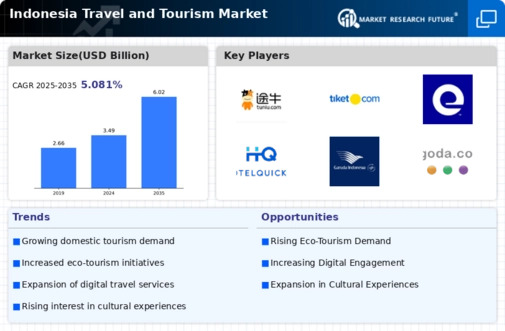Market Growth Projections
The Global Indonesia Travel and Tourism Market Industry is poised for substantial growth, with projections indicating a market size of 25 USD Billion in 2024 and an anticipated increase to 45 USD Billion by 2035. This growth trajectory reflects a compound annual growth rate (CAGR) of 5.49% from 2025 to 2035. Such figures underscore the potential for investment and development within the sector, highlighting the importance of strategic planning and resource allocation to capitalize on emerging opportunities. The market's expansion is likely to be driven by various factors, including increased travel demand, government support, and evolving consumer preferences.
Sustainable Tourism Practices
The increasing emphasis on sustainable tourism practices is becoming a defining characteristic of the Global Indonesia Travel and Tourism Market Industry. As global awareness of environmental issues rises, travelers are increasingly seeking eco-friendly options and experiences that minimize their carbon footprint. Indonesia, with its rich biodiversity and unique ecosystems, has the potential to lead in sustainable tourism initiatives. This focus on sustainability not only attracts environmentally conscious travelers but also encourages local communities to engage in tourism development. The market's growth in this area may align with broader global trends, potentially enhancing its appeal and profitability.
Growing Middle-Class Population
The expanding middle-class population in Indonesia is a pivotal driver of the Global Indonesia Travel and Tourism Market Industry. As disposable incomes rise, more individuals are likely to engage in travel and leisure activities. This demographic shift is projected to contribute significantly to the market, with the industry expected to reach 25 USD Billion in 2024. The increasing purchasing power allows families to invest in domestic and international travel, thereby enhancing the overall tourism experience. This trend suggests a robust demand for diverse travel options, including eco-tourism and cultural experiences, which are becoming increasingly popular among Indonesian travelers.
Cultural and Natural Attractions
Indonesia's rich cultural heritage and diverse natural landscapes are significant drivers of the Global Indonesia Travel and Tourism Market Industry. The archipelago boasts numerous UNESCO World Heritage Sites, vibrant festivals, and stunning natural wonders, such as Bali and Komodo Island. These attractions not only draw international tourists but also encourage domestic travel. The unique blend of culture and nature provides a compelling reason for travelers to explore various regions of Indonesia. This intrinsic value of cultural and natural offerings is expected to sustain the market's growth, contributing to a projected CAGR of 5.49% from 2025 to 2035.
Digital Transformation in Travel Services
The digital transformation of travel services is reshaping the Global Indonesia Travel and Tourism Market Industry. The rise of online booking platforms, mobile applications, and digital marketing strategies has made travel planning more accessible and efficient for consumers. This shift allows travelers to compare prices, read reviews, and book experiences at their convenience. As technology continues to evolve, it is likely to enhance customer engagement and satisfaction, driving more individuals to explore Indonesia's offerings. The integration of technology into travel services may further bolster the market, supporting its growth trajectory in the coming years.
Government Initiatives and Infrastructure Development
Government initiatives aimed at enhancing tourism infrastructure play a crucial role in the Global Indonesia Travel and Tourism Market Industry. Investments in transportation, accommodation, and attractions are likely to improve accessibility and overall visitor experience. The Indonesian government has prioritized tourism development, with plans to increase the number of international airports and improve road networks. Such efforts may lead to a more seamless travel experience, attracting both domestic and international tourists. As a result, the market is anticipated to grow, potentially reaching 45 USD Billion by 2035, reflecting the positive impact of these initiatives on tourism.

























Leave a Comment